University Supply Chain Management Homework Assignment: Chapters 9-11
VerifiedAdded on 2022/08/18
|5
|786
|14
Homework Assignment
AI Summary
This homework assignment addresses key concepts in supply chain management, drawing from Chapters 9, 10, and 11 of the textbook. The solution explores challenges in supplier development, such as process non-transparency and biased contract conflicts, and discusses when to use multiple versus fewer suppliers. It defines reshoring and nearshoring, and analyzes the benefits of foreign trade zones. The assignment also examines the use of internet-based cost and price information, using an example from the American Steel industry, and the concept of total cost of ownership (TCO), outlining its advantages, such as considering the entire cost element, and disadvantages, like its complex implementation.
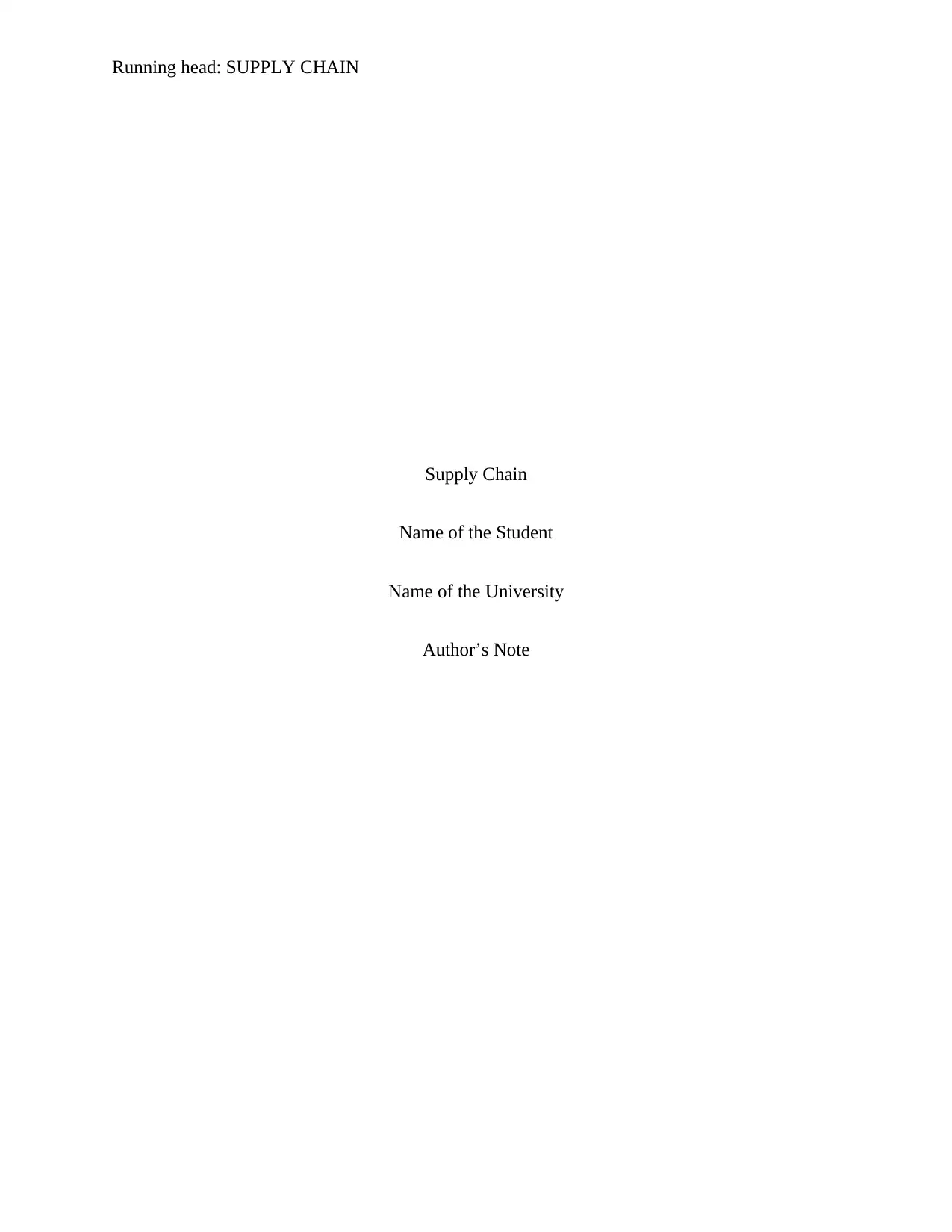
Running head: SUPPLY CHAIN
Supply Chain
Name of the Student
Name of the University
Author’s Note
Supply Chain
Name of the Student
Name of the University
Author’s Note
Paraphrase This Document
Need a fresh take? Get an instant paraphrase of this document with our AI Paraphraser
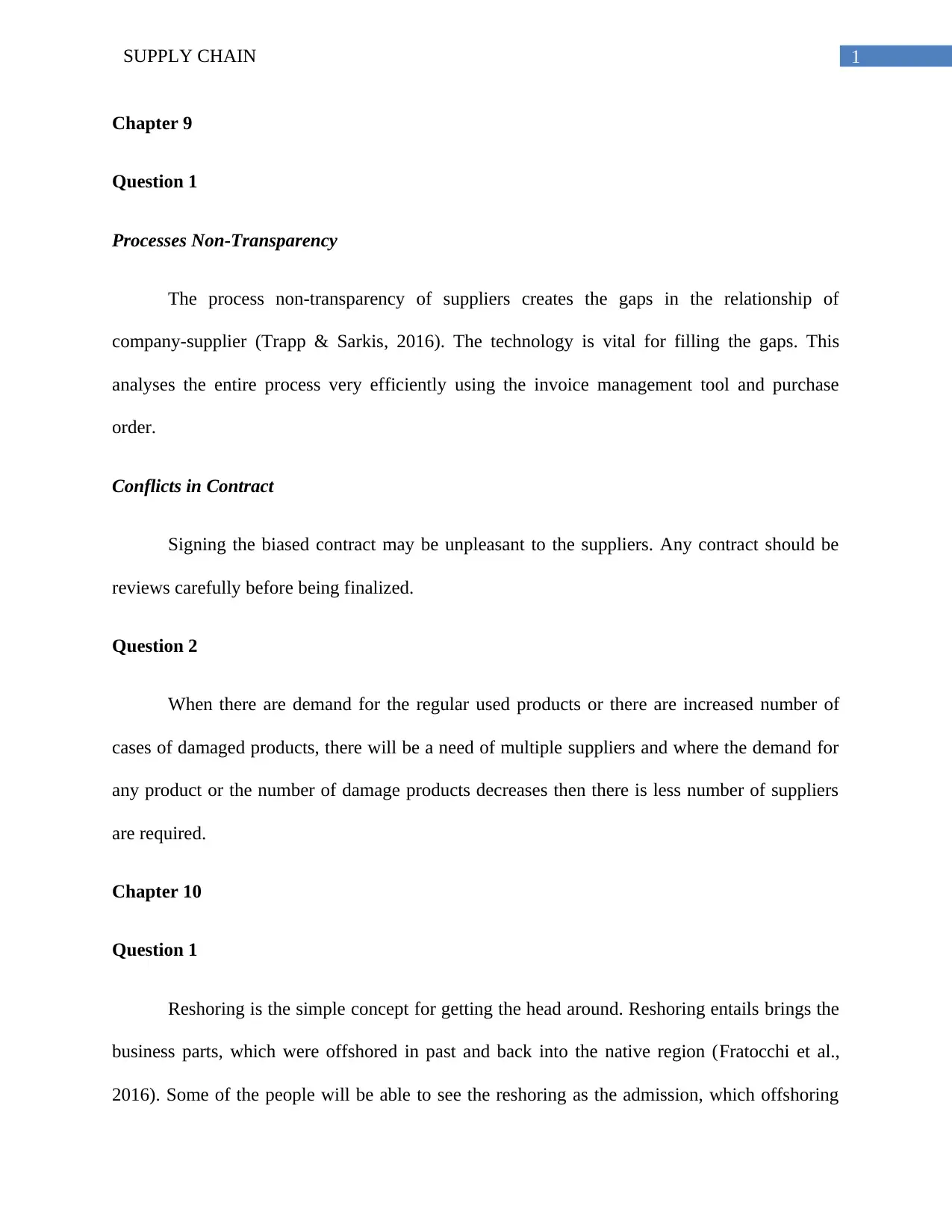
1SUPPLY CHAIN
Chapter 9
Question 1
Processes Non-Transparency
The process non-transparency of suppliers creates the gaps in the relationship of
company-supplier (Trapp & Sarkis, 2016). The technology is vital for filling the gaps. This
analyses the entire process very efficiently using the invoice management tool and purchase
order.
Conflicts in Contract
Signing the biased contract may be unpleasant to the suppliers. Any contract should be
reviews carefully before being finalized.
Question 2
When there are demand for the regular used products or there are increased number of
cases of damaged products, there will be a need of multiple suppliers and where the demand for
any product or the number of damage products decreases then there is less number of suppliers
are required.
Chapter 10
Question 1
Reshoring is the simple concept for getting the head around. Reshoring entails brings the
business parts, which were offshored in past and back into the native region (Fratocchi et al.,
2016). Some of the people will be able to see the reshoring as the admission, which offshoring
Chapter 9
Question 1
Processes Non-Transparency
The process non-transparency of suppliers creates the gaps in the relationship of
company-supplier (Trapp & Sarkis, 2016). The technology is vital for filling the gaps. This
analyses the entire process very efficiently using the invoice management tool and purchase
order.
Conflicts in Contract
Signing the biased contract may be unpleasant to the suppliers. Any contract should be
reviews carefully before being finalized.
Question 2
When there are demand for the regular used products or there are increased number of
cases of damaged products, there will be a need of multiple suppliers and where the demand for
any product or the number of damage products decreases then there is less number of suppliers
are required.
Chapter 10
Question 1
Reshoring is the simple concept for getting the head around. Reshoring entails brings the
business parts, which were offshored in past and back into the native region (Fratocchi et al.,
2016). Some of the people will be able to see the reshoring as the admission, which offshoring
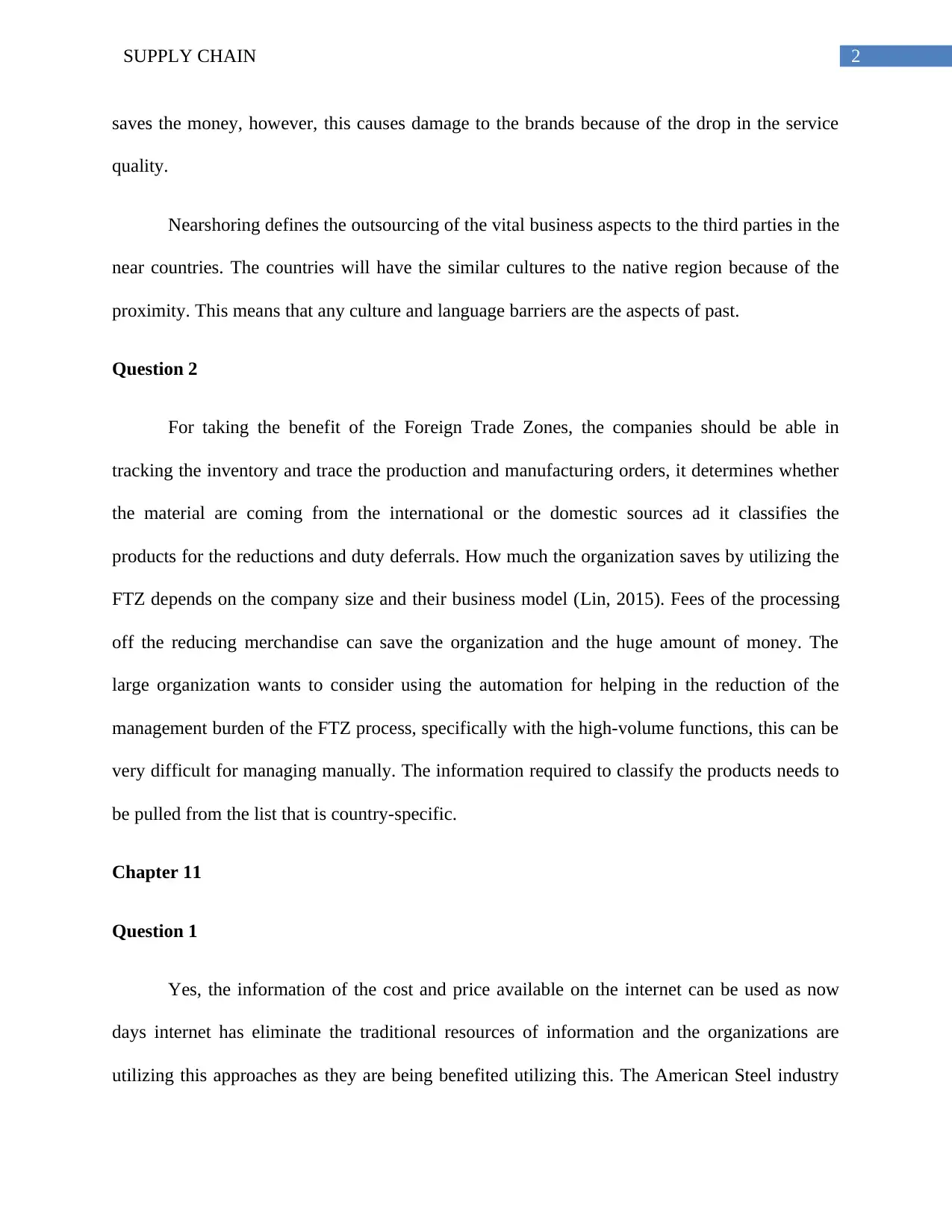
2SUPPLY CHAIN
saves the money, however, this causes damage to the brands because of the drop in the service
quality.
Nearshoring defines the outsourcing of the vital business aspects to the third parties in the
near countries. The countries will have the similar cultures to the native region because of the
proximity. This means that any culture and language barriers are the aspects of past.
Question 2
For taking the benefit of the Foreign Trade Zones, the companies should be able in
tracking the inventory and trace the production and manufacturing orders, it determines whether
the material are coming from the international or the domestic sources ad it classifies the
products for the reductions and duty deferrals. How much the organization saves by utilizing the
FTZ depends on the company size and their business model (Lin, 2015). Fees of the processing
off the reducing merchandise can save the organization and the huge amount of money. The
large organization wants to consider using the automation for helping in the reduction of the
management burden of the FTZ process, specifically with the high-volume functions, this can be
very difficult for managing manually. The information required to classify the products needs to
be pulled from the list that is country-specific.
Chapter 11
Question 1
Yes, the information of the cost and price available on the internet can be used as now
days internet has eliminate the traditional resources of information and the organizations are
utilizing this approaches as they are being benefited utilizing this. The American Steel industry
saves the money, however, this causes damage to the brands because of the drop in the service
quality.
Nearshoring defines the outsourcing of the vital business aspects to the third parties in the
near countries. The countries will have the similar cultures to the native region because of the
proximity. This means that any culture and language barriers are the aspects of past.
Question 2
For taking the benefit of the Foreign Trade Zones, the companies should be able in
tracking the inventory and trace the production and manufacturing orders, it determines whether
the material are coming from the international or the domestic sources ad it classifies the
products for the reductions and duty deferrals. How much the organization saves by utilizing the
FTZ depends on the company size and their business model (Lin, 2015). Fees of the processing
off the reducing merchandise can save the organization and the huge amount of money. The
large organization wants to consider using the automation for helping in the reduction of the
management burden of the FTZ process, specifically with the high-volume functions, this can be
very difficult for managing manually. The information required to classify the products needs to
be pulled from the list that is country-specific.
Chapter 11
Question 1
Yes, the information of the cost and price available on the internet can be used as now
days internet has eliminate the traditional resources of information and the organizations are
utilizing this approaches as they are being benefited utilizing this. The American Steel industry
⊘ This is a preview!⊘
Do you want full access?
Subscribe today to unlock all pages.

Trusted by 1+ million students worldwide
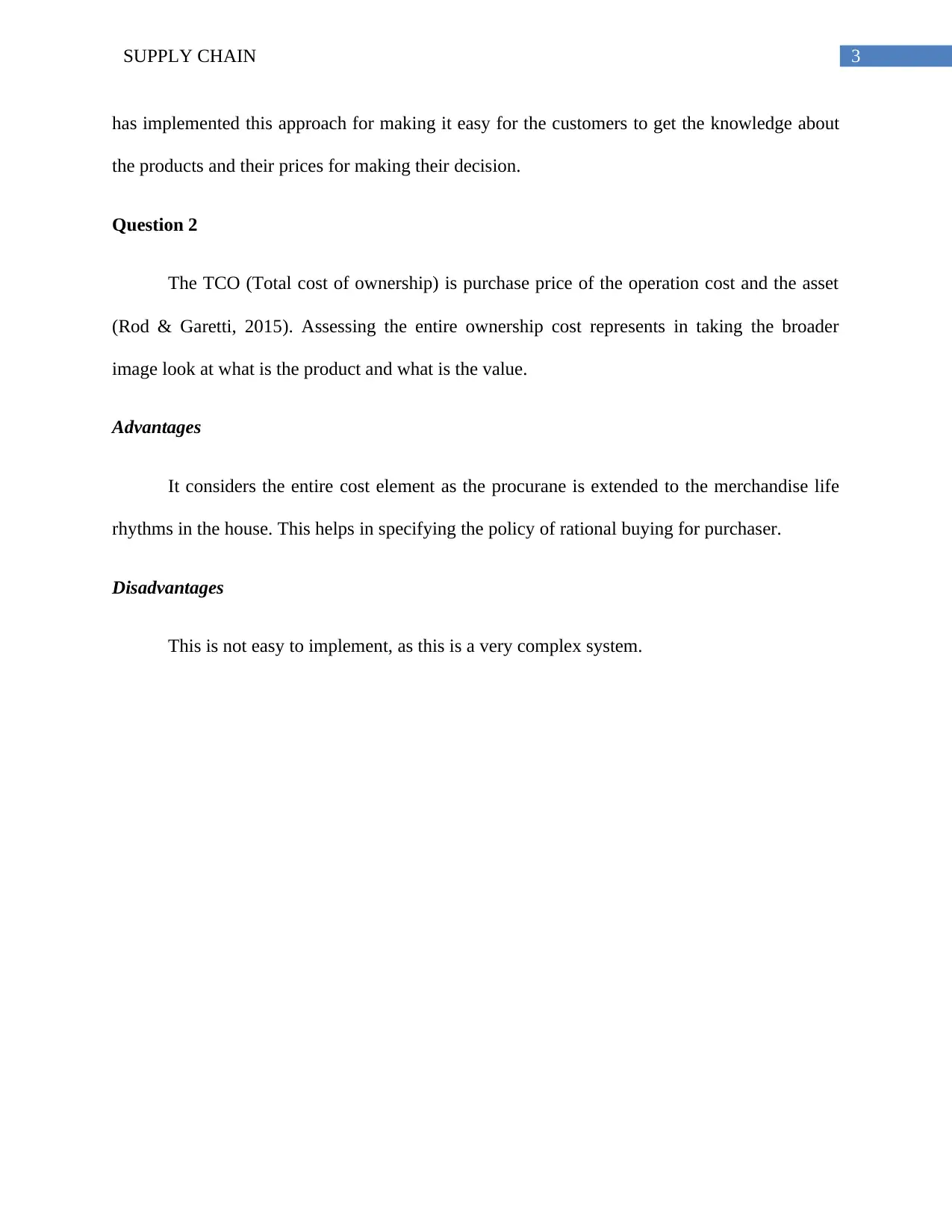
3SUPPLY CHAIN
has implemented this approach for making it easy for the customers to get the knowledge about
the products and their prices for making their decision.
Question 2
The TCO (Total cost of ownership) is purchase price of the operation cost and the asset
(Rod & Garetti, 2015). Assessing the entire ownership cost represents in taking the broader
image look at what is the product and what is the value.
Advantages
It considers the entire cost element as the procurane is extended to the merchandise life
rhythms in the house. This helps in specifying the policy of rational buying for purchaser.
Disadvantages
This is not easy to implement, as this is a very complex system.
has implemented this approach for making it easy for the customers to get the knowledge about
the products and their prices for making their decision.
Question 2
The TCO (Total cost of ownership) is purchase price of the operation cost and the asset
(Rod & Garetti, 2015). Assessing the entire ownership cost represents in taking the broader
image look at what is the product and what is the value.
Advantages
It considers the entire cost element as the procurane is extended to the merchandise life
rhythms in the house. This helps in specifying the policy of rational buying for purchaser.
Disadvantages
This is not easy to implement, as this is a very complex system.
Paraphrase This Document
Need a fresh take? Get an instant paraphrase of this document with our AI Paraphraser
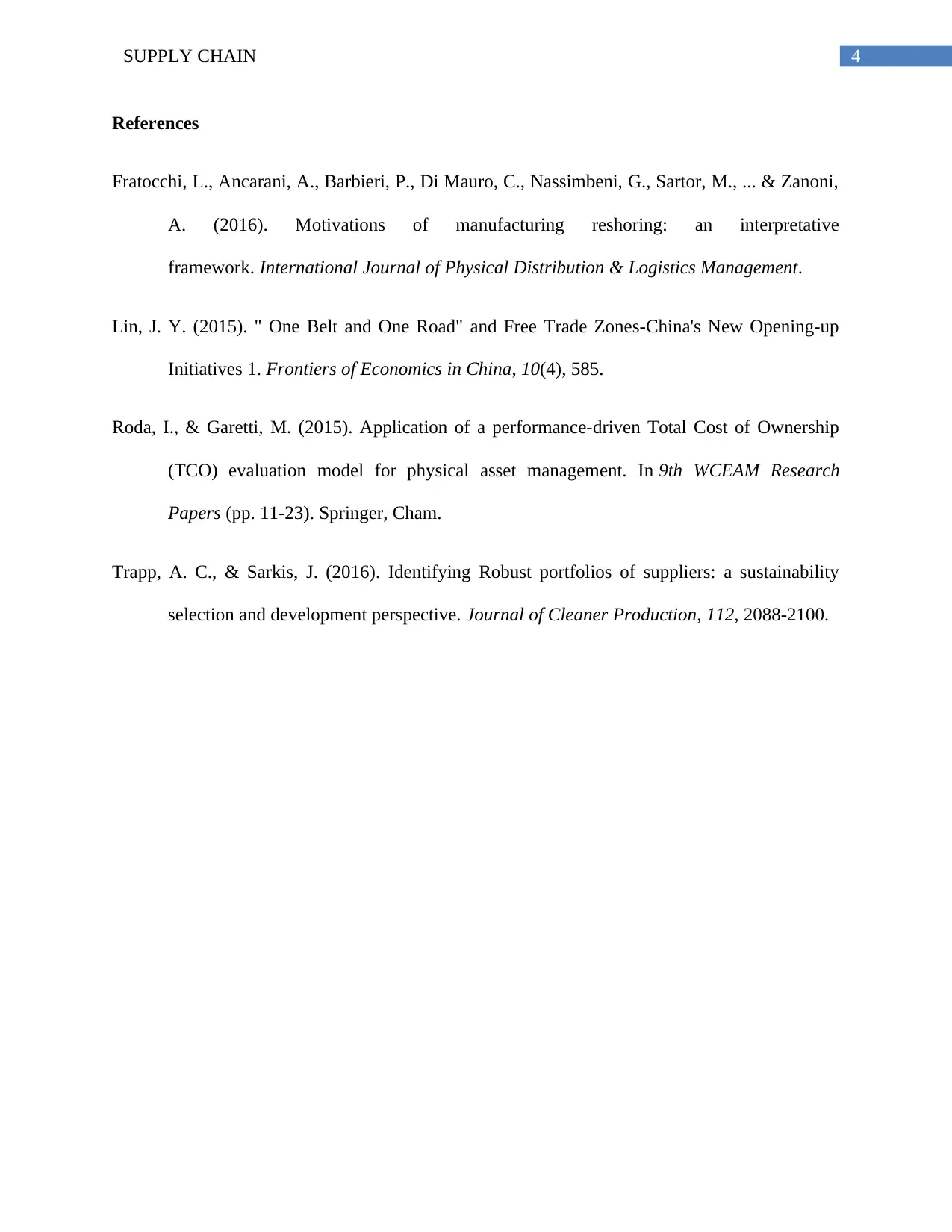
4SUPPLY CHAIN
References
Fratocchi, L., Ancarani, A., Barbieri, P., Di Mauro, C., Nassimbeni, G., Sartor, M., ... & Zanoni,
A. (2016). Motivations of manufacturing reshoring: an interpretative
framework. International Journal of Physical Distribution & Logistics Management.
Lin, J. Y. (2015). " One Belt and One Road" and Free Trade Zones-China's New Opening-up
Initiatives 1. Frontiers of Economics in China, 10(4), 585.
Roda, I., & Garetti, M. (2015). Application of a performance-driven Total Cost of Ownership
(TCO) evaluation model for physical asset management. In 9th WCEAM Research
Papers (pp. 11-23). Springer, Cham.
Trapp, A. C., & Sarkis, J. (2016). Identifying Robust portfolios of suppliers: a sustainability
selection and development perspective. Journal of Cleaner Production, 112, 2088-2100.
References
Fratocchi, L., Ancarani, A., Barbieri, P., Di Mauro, C., Nassimbeni, G., Sartor, M., ... & Zanoni,
A. (2016). Motivations of manufacturing reshoring: an interpretative
framework. International Journal of Physical Distribution & Logistics Management.
Lin, J. Y. (2015). " One Belt and One Road" and Free Trade Zones-China's New Opening-up
Initiatives 1. Frontiers of Economics in China, 10(4), 585.
Roda, I., & Garetti, M. (2015). Application of a performance-driven Total Cost of Ownership
(TCO) evaluation model for physical asset management. In 9th WCEAM Research
Papers (pp. 11-23). Springer, Cham.
Trapp, A. C., & Sarkis, J. (2016). Identifying Robust portfolios of suppliers: a sustainability
selection and development perspective. Journal of Cleaner Production, 112, 2088-2100.
1 out of 5
Your All-in-One AI-Powered Toolkit for Academic Success.
+13062052269
info@desklib.com
Available 24*7 on WhatsApp / Email
![[object Object]](/_next/static/media/star-bottom.7253800d.svg)
Unlock your academic potential
Copyright © 2020–2025 A2Z Services. All Rights Reserved. Developed and managed by ZUCOL.


